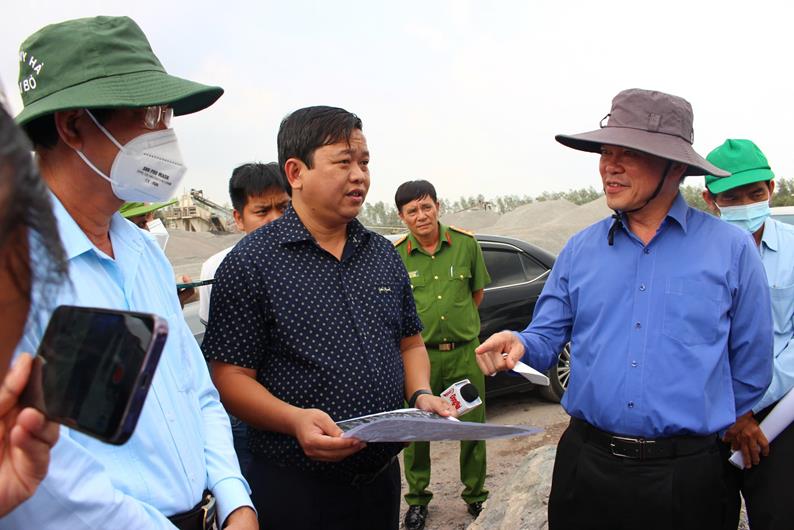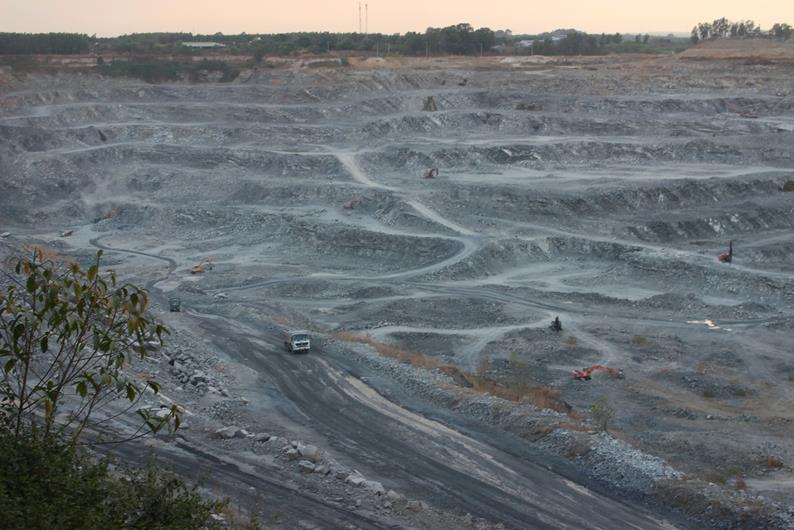(News Portal – Dong Nai) – Dong Nai holds a large number of mineral reserves in the Southeast region. The planning of land for mineral exploitation to serve socio-economic development is necessary, yet it requires careful consideration to use this finite resource effectively and sustainably.

Provincial Party Secretary Nguyen Hong Linh inspecting a mineral mining site in Bien Hoa City
Persistent Issues in Management and Mineral Exploitation
For many years, Dong Nai has planned over 1,300 hectares of land for mineral exploitation purposes. Most of this area is located in Vinh Cuu District (458 hectares), Bien Hoa City (388 hectares), Xuan Loc District (198 hectares), Thong Nhat District (175 hectares), and scattered across other localities. Thanks to the resource advantage, the province has planned and licensed numerous mineral exploitation projects, generating additional revenue for the budget and providing employment for thousands of local workers. More importantly, the construction materials supply meets the socio-economic development needs of the province and southern regions.
Deputy Director of the Department of Natural Resources and Environment Nguyen Ngoc Hung assessed that over the years, mineral mines in the province have complied with regulations on paying fees for mineral exploitation rights, resource taxes, and environmental fees. The mineral mines have essentially ensured sufficient materials for transportation projects and infrastructure development.
However, according to the Department of Natural Resources and Environment, there are still certain issues and challenges in mineral exploitation activities. Enterprises have only implemented environmental protection measures within the mining area, and transportation processes have caused road damage and dust dispersion. The closure of mines and environmental restoration post-exploitation is slow. Illegal sand and soil extraction for land leveling still occurs.
Additionally, there is a situation where mineral exploitation does not follow plans and mine designs, leading to resource depletion and waste. Deep processing of minerals has not been prioritized. Other limitations include a lack of quantity and quality in state management personnel regarding minerals, and ineffective coordination between various levels and sectors.
Moreover, the overlapping and inconsistency between laws such as the Mineral Law, Land Law, Investment Law, etc., have led to issues in mineral exploitation rights auctions and the calculation of fees for exploitation rights. Projects for dredging canals, reservoirs, and agricultural land improvement combined with mineral recovery lack specific guidance.
Over the past two years, many key transportation projects have faced soil shortages for foundation work because some licensed mines are slow in exploitation, and potential areas are not suitable for mineral exploitation and land use planning. The province has repeatedly petitioned the Government and the Ministry of Natural Resources and Environment to address the difficulties and obstacles in processes and planning, but progress remains slow, affecting project timelines.

Mining activity in Vinh Cuu District
Efficient Use of Land and Resource
With the goal of exploiting and using mineral resources economically, efficiently, and sustainably, in the Dong Nai Provincial Planning for the period 2021-2030, with a vision to 2050, the province has planned the exploitation of 40 stone quarries with a total area of over 1,400 hectares to serve civil construction and key projects. For clay mines, exploration and exploitation of pre-planned mine sites will continue, while expanding and adding about 9 mines with a total area of over 470 hectares. Similarly, the province will review and adjust mines not suitable for land leveling material planning, adding new mine sites. There are also other types of mineral exploitation planning.
Additionally, the province has included in the exploration plan 20 construction stone mines, 4 clay tile mines, 4 sand mines, 4 peat mines, and 1 land leveling material mine with a total area of about 900 hectares. To ensure material sources for the future, protect the environment, and preserve natural landscapes, the province has also planned areas where mineral exploitation is prohibited or temporarily prohibited. These include 41 areas where construction stone mining is prohibited, with an area of more than 4,000 hectares and estimated resources of nearly 1.3 million m³; 58 areas where clay tile mining is prohibited, with a total area of over 4,700 hectares and estimated resources of 218 million m³; and 42 areas where land leveling material mining is prohibited, with an area of more than 2,200 hectares and estimated resources of about 65 million m³.
Vice Chairman of the Provincial People's Committee Vo Van Phi stated that in the future, the province will conduct an inventory of mineral resources to implement protection, exploration, and exploitation plans according to the Dong Nai Provincial Planning for the period 2021-2030, with a vision to 2050; and plans for exploration, exploitation, processing, and use of various minerals for the period 2021-2030, with a vision to 2050. Along with this, the province will strengthen geological and mineral water management; protect the environment and ensure occupational safety in mineral exploitation activities. Proactive measures will be taken to prevent, combat, and strictly handle legal violations regarding geology and minerals.
Member of the Central Party Committee, Provincial Party Secretary Nguyen Hong Linh, during a field survey of stone mines in 2023, emphasized that minerals are crucial materials for current and future socio-economic development. Therefore, planning, exploration, licensing, and mineral exploitation must be carefully calculated. Mineral exploitation must align with construction planning, land use planning, and mineral exploitation planning. Enterprises involved in mineral extraction and business must comply with approved environmental impact assessment reports and not pollute water and air sources, and must restore land post-exploitation.